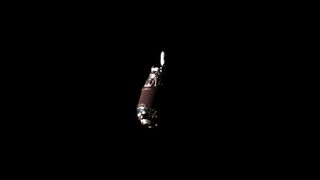
Space junk just got an epic close-up.
The ADRAS-J satellite, operated by the Japanese company Astroscale, successfully maneuvered to within a few hundred meters of a discarded rocket body this month, snapping a striking photo to memorialize the achievement.
"Behold, the world's first image of space debris captured through rendezvous and proximity operations during our ADRAS-J mission," Astroscale said today (April 26) in a post on X that shared the photo.
Related: Kessler Syndrome and the space debris problem
ADRAS-J (short for "Active Debris Removal by Astroscale-Japan") launched to Earth orbit atop a Rocket Lab Electron vehicle on Feb. 18.
The 330-pound (150 kilograms) probe's main task is to rendezvous with, and study, a big hunk of space junk — the upper stage of the Japanese H-2A rocket that launched the GOSAT Earth-observation satellite in 2009. Such work will help prove out technologies that future spacecraft can use to service satellites or capture and de-orbit debris objects, according to Astroscale.
Earlier this month, ADRAS-J got within a few hundred kilometers of the rocket body, which is about 36 feet long by 13 feet wide (11 by 4 meters). The probe then shifted into "proximity approach phase," conducting multiple maneuvers that reduced the distance to just a few hundred meters — a milestone that the newly released photo preserves for posterity.
Get the Space.com Newsletter
Breaking space news, the latest updates on rocket launches, skywatching events and more!
And more imagery is likely coming soon as well.
"In the next phase of the mission, ADRAS-J will attempt to capture additional images of the upper stage through various controlled close-approach operations," Astroscale wrote in an update today. "The images and data collected are expected to be crucial in better understanding the debris and providing critical information for future removal efforts."
Removal of the biggest, most dangerous debris objects may be necessary to keep Earth orbit safe and accessible, many exploration advocates say. Rocket bodies like the H-2A upper stage are like giant bullets whizzing around Earth; if they slam into another hunk of junk or an active satellite, the smashup could spawn a debris cloud that could lead to a catastrophic collision cascade.
The newly released ADRAS-J photo is not the first up-close view of space junk that we've ever seen, as spaceflight historian Gunther Krebs noted.
In 2003, the U.S. Air Force Research Laboratory's XSS-10 satellite met up with the spent upper stage of a Delta II rocket and snapped an image of the object. However, this was a less complex task than the one ADRAS-J just achieved; XSS-10 had launched aboard that same Delta II.
Join our Space Forums to keep talking space on the latest missions, night sky and more! And if you have a news tip, correction or comment, let us know at: community@space.com.

Michael Wall is a Senior Space Writer with Space.com and joined the team in 2010. He primarily covers exoplanets, spaceflight and military space, but has been known to dabble in the space art beat. His book about the search for alien life, "Out There," was published on Nov. 13, 2018. Before becoming a science writer, Michael worked as a herpetologist and wildlife biologist. He has a Ph.D. in evolutionary biology from the University of Sydney, Australia, a bachelor's degree from the University of Arizona, and a graduate certificate in science writing from the University of California, Santa Cruz. To find out what his latest project is, you can follow Michael on Twitter.
-
Homer10 Here's how I would approach orbital object removal. Removal vehicle maneuvers close to the object. A claw like device on the removal vehicle grips the object. the claw is let out on a long cable (1 mile long), and a rotation of the vehicle and object is started. This rotation is enhanced by the drag of the very thin atmosphere. the rotation must be perpendicular to the direction of orbit. The rotation speed increases to a certain point where the regressing direction of the rotation causes the object to loose enough speed to fall out of orbit. However the Object removal vehicle balances out the system resulting in the two objects together having the correct orbital velocity. Now at a precise moment in the rotation, when the Object removal vehicle is advancing, and the object of interest (space junk) is regressing compared to the total orbital motion, the claw is released. The two objects zoom away from each other with the momentum in the object of interest is lost to the Object removal vehicle. The object of interest (space junk) now falls out of orbit, and burns up. The Object removal vehicle is propelled into a higher orbit by the momentum stolen from the object of interest (space junk), and goes off to intercept another object of interest (space junk). This method would be very useful in removing larger objects in orbit.Reply -
Classical Motion I have a feeling that with the reduced weight and size without losing function, many more countries and private companies will be putting sats in orbit. For all kinds of reasons and profits.Reply
Trying to pick pieces probably couldn't keep up with new deposits.
We need to figure a way to sweep our orbital area of junk. Individual attention would take forever. And lots of it is too small.
Not to mention an incentive. A prize perhaps. Large enough to form business compacts. -
billslugg Matching speeds with debris is capital intensive and requires lots of delta V. I would put a large laser up there combined with a radar and ablate each piece in its forward direction enough to cause reentry. One satellite could deal with thousands of pieces of debris every day. It only takes a small amount of delta V to deorbit from LEO, about 20 m/s.Reply
